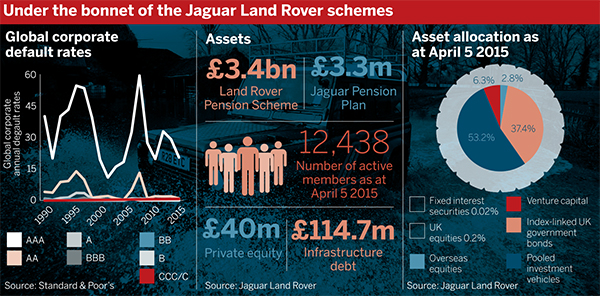Jaguar Land Rover has decided to alter the strategic asset allocation in its two pension schemes by boosting its exposure to global credit, while decreasing assets held for the purposes of matching changes in the fund’s liabilities.
Low interest rates over the past few years have prompted many defined benefit pension funds to further diversify their liability-matching portfolios in the search for higher yields. Experts say that while schemes still want to manage their liability risks, they are looking to do so more efficiently.

Trustees of the Land Rover Pension Scheme and the Jaguar Pension Plan agreed to increase the exposure to global investment-grade credit, with a corresponding reduction to the liability-matching asset allocation, according to the schemes’ latest annual reports.
If you can manage your risk and increase your return, why would you not look for opportunities to do that?
Tim Giles, Aon Hewitt
The reports state that the schemes aim to implement the changes over an extended timeframe of about two years, starting from the middle of 2014.
At the moment, the funds’ investment strategy is to diversify return-seeking assets, opt for active management where necessary, and use a variety of instruments that provide a better match to alterations in liabilities.
The long-term objective is to be fully funded on a prudent measure of liabilities by 2035.
The funds also put into place a number of other asset allocation changes during the period, to increase diversification and the use of active management. These included a commitment to infrastructure debt worth a combined £114.7m, and a total investment of $58m (£40m) in private equity.
Driving on with diversification
Tim Giles, head of UK investment consulting at Aon Hewitt, said that given the way interest rates have moved in recent years, many schemes find that their liability-matching strategies are very cash rich.
While funds are still able to carry out the level of liability-matching they require today, they can also start looking for other opportunities in terms of investing this cash. Increasing exposure to investment-grade credit in the US, for example, will provide a bit more diversification, he said.
Giles added that it is not uncommon for funds to move cash from their hedging instruments to other investments that they see as having a better yield in the long term.
Taking money from liability-matching assets and then committing to global credit “is about hunting for better yield and better diversification” with regard to how that yield is being earned.
Giles said that as schemes mature, the liability-matching portfolio becomes a bigger proportion of the total assets. It is then a question of managing liability risks more efficiently.
“Ultimately, if you can manage your risk and increase your return, why would you not look for opportunities to do that?” he said.
Efficient liability hedging
“There is a good case for investing in global credit,” said Shajahan Alam, senior solutions manager in AXA Investment Managers’ UK LDI team.
One of the main benefits is diversification, he added; when investing in global credit, a scheme has exposure to a larger number of sectors, leading to a more regionally diverse allocation.
In addition, Alam said, being exposed to bonds in different currencies means “you get better value”, while having the same credit risk.
He added that with regard to hedging, global credit can fit into an LDI framework quite well due to the use of derivative instruments.
Having a single collateral pot also plays a role, as it can hedge unwanted risk on a credit portfolio as well as unwanted risk on the liabilities side.
“If you’ve got all your collateral in one place then you can do all the hedging that you need on your global credit more efficiently,” he said.
David Will, senior investment consultant at JLT Employee Benefits, said: “There’s certainly a move to blend liability-driven investment with buy-and-maintain credit.”
He pointed out, however, that this option depends on the type of scheme and its funding position.
In general terms, “LDI and the use of leverage, which admittedly has become more expensive, is still a very efficient way of seeking to hedge interest rate and inflation risk”, Will said.














